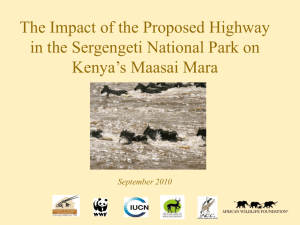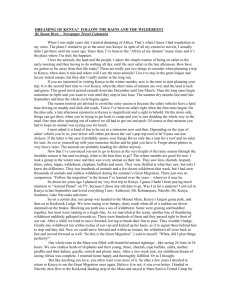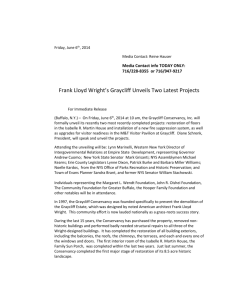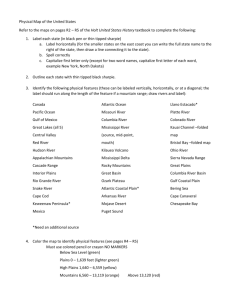Wildlife-report-May-2014-email
advertisement
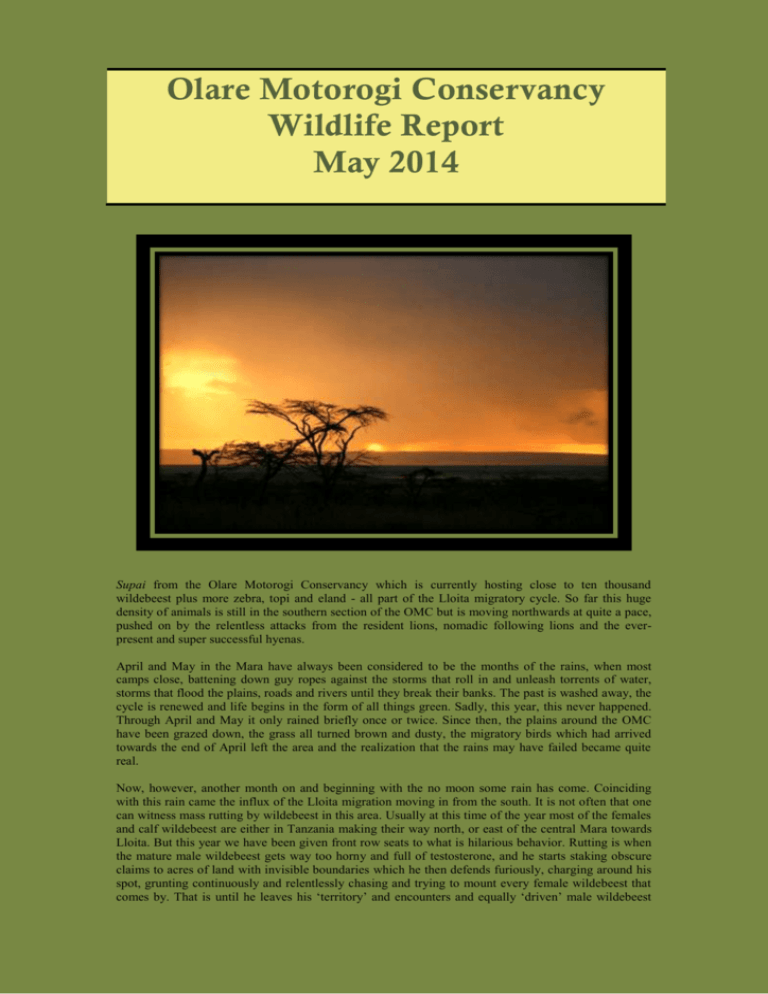
Olare Motorogi Conservancy Wildlife Report May 2014 Supai from the Olare Motorogi Conservancy which is currently hosting close to ten thousand wildebeest plus more zebra, topi and eland - all part of the Lloita migratory cycle. So far this huge density of animals is still in the southern section of the OMC but is moving northwards at quite a pace, pushed on by the relentless attacks from the resident lions, nomadic following lions and the everpresent and super successful hyenas. April and May in the Mara have always been considered to be the months of the rains, when most camps close, battening down guy ropes against the storms that roll in and unleash torrents of water, storms that flood the plains, roads and rivers until they break their banks. The past is washed away, the cycle is renewed and life begins in the form of all things green. Sadly, this year, this never happened. Through April and May it only rained briefly once or twice. Since then, the plains around the OMC have been grazed down, the grass all turned brown and dusty, the migratory birds which had arrived towards the end of April left the area and the realization that the rains may have failed became quite real. Now, however, another month on and beginning with the no moon some rain has come. Coinciding with this rain came the influx of the Lloita migration moving in from the south. It is not often that one can witness mass rutting by wildebeest in this area. Usually at this time of the year most of the females and calf wildebeest are either in Tanzania making their way north, or east of the central Mara towards Lloita. But this year we have been given front row seats to what is hilarious behavior. Rutting is when the mature male wildebeest gets way too horny and full of testosterone, and he starts staking obscure claims to acres of land with invisible boundaries which he then defends furiously, charging around his spot, grunting continuously and relentlessly chasing and trying to mount every female wildebeest that comes by. That is until he leaves his ‘territory’ and encounters and equally ‘driven’ male wildebeest neighbor. They run in, drop to their knees and slam their horns together sending a crash across the plains. After this they get up, shake their heads as if to say sorry, before returning to harass in their own areas. Sex pests in overdrive! Onto some of the characters of conservancy, starting with the cheetah for a change… Narasha was, as of this morning, on the plains east of the hammerkop stream. Amazingly the past week has been very quiet on the cheetah front, it is funny how this happens from time to time. It may be because of cheetah having large ranges that allow them to follow the regional migratory patterns. Either way if it is true we should be seeing lots more of the spotted cats in the near future. Amani and her little one have been around this month, these two have spent much of their time between the Seketa valley, Kicheche and Herman’s valley. Siriowa, the big male, was last around at the end of April so we hope to see him back again soon. The leopards of the OMC, if put on a podium for first, second and third positions in terms of sightings, Fig, as always, would have to be first. She is now a two-and-a-half-year-old, very successful and relaxed leopard who seems to revel in the glory of being the center of attention. Since the period about two months back when she disappeared for a couple of weeks Fig has been a regular. This morning she was found sitting with her kill in a dead tree. She has four quite severe bite wounds, fresh from last night, and despite the kill being almost finished, she did not look well fed. We can guess that another leopard, probably Yellow (the resident Casanova), found her with her kill, beat her up and took it. Such is the way of the wild. Her bites are not too serious and she seems to be moving fine although a little stiff. This is the second time she has been scuffed up, the first time it almost cost her life when she was jumped by a lioness. In addition to Yellow in the OMC, his nemesis in the reserve has been spotted once or twice. Kali, as he is called by some, is a huge leopard with a large ‘dewlap’ of skin hanging from his chin to his neck. In the past he was always found more in the reserve from Kaboso to Double-Crossing. Now, however, in the past few months he has been spending much of his time nearer the conservancy boundary in areas we would have said belonged to Yellow in the past. The last time Kali was spotted was about a week ago, half a kilometer inside the reserve on the Ntiakitaik River. He was having a stand-off with some lionesses. The lionesses from the Double-Crossing pride are wary of him - not surprising after six of them cornered him last year in an attempt to kill him. After two hours of cat fights (six lions against one leopard) Kali held them off before making his escape, leaving behind some very angry and sore lionesses. It is not surprising Yellow is conceding territory. Not much from Acacia his month but interestingly the leopardess from around Mara Plains, Mystery, was found at the end of last month along the Porini confluences. She was marking lots as she moved around, openly staking a claim to the thickets and river lines that were Acacia’s home in the past. It was exciting also to note that Mystery was heavily lactating. This was confirmed by one of the Olare camp guides who saw her with a cub just days later. We wish these two the best of luck but knowing that this leopardess lives up to her name they will probably disappear again. Hidden in plain sight. Onto the lions of the OMC, who are having a great year… Three times in the last six months the Lloita herds have moved through, an occurrence that usually might happen only once in the same time. This has been a time of plenty for the conservancy’s big cats, possibly being part of the cause for the prides to split into smaller groups. Interestingly the split in both the Moniko and Enkoyeni prides has been along maturity lines with the sub-adults from each pride seemingly staying behind while the lionesses move to other parts of their pride’s range. Another reason for this split may be the adult lionesses needing to move into the rocky, thicketed maternity areas to have their cubs. Watch this space. Lots of quite exciting dynamics have been happening in the lion world here recently. The sub-adults from the southern prides have used this glut of food to develop their hunting and killing skills. At the same time in the past couple of nights, two young males (we called them the blonde’s in our last report) and two females returned to the conservancy following the herds in. One of the youngsters was mating with one of the lionesses, or at least he was trying to, he got points for persistence! Then, one hill over, the two big double-crossing males were roaring their challenges towards the blondes. On the night of the 31st it sounded like everything happened all at once. From the results we can only guess that the Moniko sud-adults killed a wildebeest on the Moniko plains, the two young males and two females arrived, there was a scrap (throw some hyenas and jackals in there too for good measure) and in the morning the seven of the Moniko sub-adults were on Naronyo hill a couple of kilometers away, the two brothers were on the Moniko plains and the one mating with the female had some nasty bites and scratches. As with their southern Moniko and Enkoyeni neighbors, the two more secretive Seketa and Motorogi prides have seemingly also split up. They are currently scattered through the thickets, outcrops and riverine sections of the Ntiakitiak Gorge, the Olkuroto River and the Nontepes and Motorogi salt licks. If you ever plan to visit the OMC make sure you get up into this area. It is just so different to anywhere else in the Mara with a great abundance and variety but with a very low vehicle density. Onto some of the other wildlife in the area. We have been so happy to play host to lots of elephant this past month. The OMC is not considered the best habitat for elephant, and their distribution maps show this, but this conservancy is a corridor route from the areas to the east (Naibosho, Olkinyei, Siana, Lloita) to the Mara River and the swamps of Musiara. Their presence here in large herds of up to 30 may be in part due to the drought and the lack of water in the north and east. An adult elephant will drink between 70-200 liters a day (10-30 gallons!) so you can imagine the impact a family of ellies with trunks as ‘straws’ has at a little pool. Also around lots have been the herds of eland that we associate with the Lloita migration. These herds are made up of bachelor groups and cow and calf crèches that migrate over the greater area following the most nutritious shoots. Unlike other antelope, eland are non-territorial so migrating suites them very well. Some of the more special sightings and highlights of the month: Bat-eared fox pups (can you imagine?) Lots of little impala’s and gazelles new on the scene Amazing sunsets caused by the smoke and dust in the atmosphere The arrival of the herds (twice) The arrival of the rain after so much heat - the smell of the rain on the dry earth is a highlight in itself The multiple families of elephants The hatchings of the various bugs after the rains The grunting and horn crashing of the rutting bull wildebeest Watching the new generation of OMC lions become self-dependent in this time of plenty. There is always so much more that one could add to a list like this but in all honesty it would just become a long-winded way of trying to entice you here to experience it for yourselves. The best we can do in finishing is to say now, as we move into what is called the ‘high season’ here in the Mara, it is once again clear to those of us that have had the incredible opportunity of being able to work here for a number of years, that the low season - these past few months of quiet before the storm - are really some of the best the area has to offer in terms of sightings, experiences, photography, peace, tranquility and exclusivity. The OMC and other northern Mara conservancies are always amazing at any time of year. No matter when you visit there will always be something happening, something that happens at no other time of year, and these happenings are part of the conservancy’s stunning cycle of life. Remove one, and the whole cycle collapses. That’s why you should some to the Mara, to see it for yourself. That’s why I love Kenya. Richard Pye OMC Warden Thanks also to Nic Elliot of the Mara Predator Project for his input on the OMC’s lions. Photo Credits: Sunset Fig’s Kill Moniko sub-adults Beaten up blonde Fig into sunrise Lorna B Jardine Lorna B Jardine Lorna B Jardine Lorna B Jardine Lorna B Jardine



